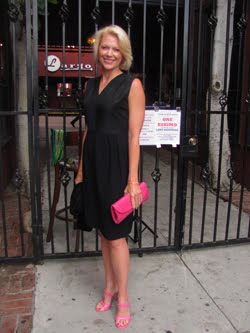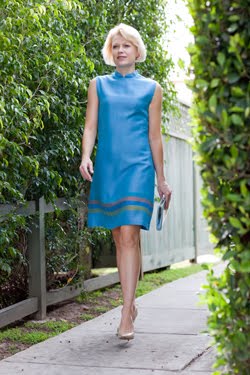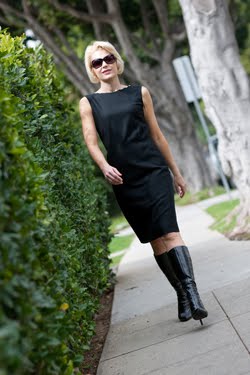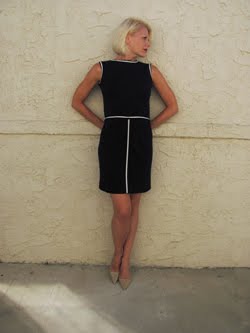The journey of this film begins many years before it was made with the story of its director and star. Much has been written about the relationship between von Sternberg and Dietrich who first met in Berlin while she was a struggling young actress and he was a colleague of her husband Rudolf (Rudi) Sieber. Though still rather raw and untrained, there was something about how Marlene's aristocratic attitude mixed with an understanding of the seedier side of the city that entranced the young director. He saw the potential in the slightly overweight German girl and helped her make the most of her time in front of the camera. He fell in love with her while making her a star in Germany with 1930's The Blue Angel, a film that made such an impact that Hollywood quickly came calling. Paramount signed them to a contract and the lovers moved to Los Angeles to make movies for the studio--first, the iconic Morocco (1930), which premiered that same year, and then Dishonored (1931). Though The Blue Angel and Morocco both launched the actress and gained the world's attention, it's really 1932's Shanghai Express that made her a superstar.
By this fourth film with Marlene, her onscreen persona had evolved from sassy cabaret singer to mysterious femme fatale. Von Sternberg now also knew just how to shoot her. Evoking the feel of German Expressionism, he used shadows and light to draw angles in her slightly rounded face. Even Marlene marveled at the transformation:
He has changed the tone of my hair with light, using a backlight so skillfully that it touches only the tips of my hair, causing a glow like a halo....He hollows my cheeks with shadows, widens the look of my eyes, and I am fascinated by that face up there on the screen...[I] look forward to the rushes each day to see what I, his creature, will look like.
Though the lighting was really the result of the prodigious talent and loving eyes of von Sternberg, he was not a member of the guild and therefore could not be given credit. The equally talented Lee Garmes had worked alongside the director since Morocco, and was the official cinematographer for each of their productions (along with an uncredited assist from another cinematography god James Wong Howe). Since the lighting on Shanghai Express was so extraordinary, lighting that would later influence much of the look of film noir, Garmes ended up winning the Oscar that year for Best Cinematography. Obviously, it's an award we can appreciate should be shared by von Sternberg as well.
In addition to lighting Marlene to perfection, von Sternberg also had her dressed to draw out her unique sultry appeal. On The Blue Angel, he had turned the styling over to Marlene; Rudi convinced him to have faith in her instincts, and she did not disappoint. She drew inspiration for Lola Lola's costumes from those who made up Berlin's nightlife, including her favorite "whores" in the city who combined frilly panties with garters and a top hat. The costumes for Morocco, their first American production, were much more from von Sternberg himself. It was he who decided that Marlene would appear in a tuxedo for her first cabaret act in the film; this was tremendously titillating to audiences as it hid the legs made so famous in The Blue Angel and introduced the androgyny that Marlene would become famous for. But with Morocco, an important member had been added to the team who was helping bring their full vision to life--Paramount costume designer Travis Banton.
Banton was known as a genius along with his Paramount colleague Howard Greer. Both Banton and Greer started their careers in fashion at the prestigious Lucile couturier. After Lucile, Banton then worked for two other couturiers in New York--Hattie Carnegie and Madame Frances. At Hattie Carnegie, he worked closely with other talented designers who would eventually work in film, such as Jean Louis. And at Madame Frances, Banton found international fame when Mary Pickford chose one of his designs as her wedding dress for her 1919 marriage to Douglas Fairbanks. In 1924, Greer reached out to Banton and invited his friend to join him in Hollywood. Together, the two would become known for creating the studio's "Paramount Polish."
The great Travis Banton (above)
and with his muse Marlene Dietrich at Paramount
Like Morocco, Shanghai Express has highly influential costume design. One outfit in particular is so important, it both opens and closes the film. Though it may not seem significant, even the choice of its color--black--was somewhat groundbreaking. At this time in film, black was challenging to photograph; it often came across as flat and could be difficult to distinguish the details. But Marlene, who chose the slimming color because she was feeling (rightly or wrongly) heavier than usual, had faith in von Sternberg as a master cinematographer and forged ahead.
It was also Marlene who had the inspiration to use feathers to make the character of Shanghai Lily her most exotic. That decision started everyone in the Paramount costume design department scrambling to find the right birds. Boxes of feathers from all over the world poured into Banton's studio, including ostrich, egret, bird of paradise, black swan, heron, eagle, marabou, and crow. They were all inspected and quickly dismissed for a variety of reasons ranging from size to stiffness to weight. Finally, a box of tail feathers from real Mexican fighting cocks arrived and their "black-green iridescence was so intense it shimmered through the tissue paper they were wrapped in." In a rare moment of emotion, Marlene ran to Travis and kissed him on both cheeks exclaiming, "A dream! Black, with its own light!"
Then came the hunt for the perfect veil. Marlene loved the mystery that her veiled looks had achieved in Morocco and Dishonored and was determined to do it again. Bolts and bolts of fabric were brought in from the vast store at Paramount. It took hours of testing different black veils in the salon, so many that the floor began to look like it was covered in a mass of spider webs. It was dark outside when Marlene finally tried the 41st bolt of fabric--"Black 41." As she held it in front of her, Travis let out a loud "whoop" when he saw her "face sprang to life" with the veil's "horizontal lines, like shadows cast by venetian blinds." Absolutely perfect for the mood of the movie.
Now the look of Shanghai Lily was really coming together. They made a hat with the veil attached to the black iridescent cock feathers. Then Banton designed a long bias cut gown of black crepe that was "bordered in feathers [that] crested onto her neck, tumbled along her shoulders, [and] down her arms." This gown, like all others for Marlene, was perfectly fitted to her. She adored fittings and approached them with the endurance of an athlete; she would stand still for 12-hours a day, day after day, never stopping to eat or even go to the restroom. She was so tireless that Banton's assistants were switched out in shifts so they were not exhausted. Accessories were then added; Marlene did not like her hands and frequently wore "fitted gloves of the thinnest kid" leather to disguise them, so the gown was paired with ones from Hermés and a matching Art Deco purse. It was all finished with a rope of crystal beads that cascaded down the front of the gown and helped to further elongate the look.
Von Sternberg was not shown the outfit until it was completely done, which shows the level of trust he had in both Banton and Dietrich. When he finally saw Marlene standing there on the raised platform in the designer's studio, surrounded by mirrors that reflected the glamour from all angles, he hid his own excitement. He simply said, "A superb execution of an impossible design. I congratulate you all." And with that, he walked from the room. Cheers immediately erupted from the exhausted staff and everyone celebrated with champagne.
This is the backstory of only one of the costumes from this film. Still others included luxurious fabrics like fur, velvet, and gold mesh, so you can imagine the amount of work that went into the entire production. The same can be said of the wardrobes for the rest of the films that von Sternberg, Banton, and Dietrich did together. That said, Shanghai Express is one of the most recognized and influential of Marlene's costume design--it made an impact on fashion at the time and has continued to be a source of ongoing inspiration for designers. Giorgio Armani (Italy), Jean Paul Gaultier (France), and Vera Wang (America) are just some of who have referenced Marlene's style from this film in their fashion collections in recent years. Feathers alone have been a huge trend on and off the runways for the past few Fall Fashion Weeks. Cosmetic companies, too, have paid homage to the look of Shanghai Express--from the styling in advertising (Revlon) to the name of a lipstick (Nars).
Though Shanghai Express is filled with genius talent in its director Josef von Sternberg, costume designer Travis Banton, and star Marlene Dietrich, it really took every one of them and their extended team to make this movie the masterpiece it is. It's one of those classics that has made a lasting impact in film history and an enormous legacy in fashion. Von Sternberg loved to use locations, lighting, and costumes to emphasize the exotic eroticism of his leading lady, and they all come together to perfection in Shanghai Express. Whether you love it because it's Pre-Code, proto-noir, or has an even broader appeal for you, it is an excellent example of how movies in the 1930s offered escapism to their Depression-weary audiences.
Escape for yourself onboard the Shanghai Express.
The mysterious train journey begins in Peking
A full-length view of the iconic look of Shanghai Lily
that opens and closes the film
The black bias-cut crepe gown was accented with cock feathers
along with a crystal necklace and matching Art Deco kid leather gloves and purse by Hermés
This time, the feathers are from white egret
and used on the hat in order to help break up the otherwise all black ensemble
Marlene loved this look so much she wore it offscreen
as seen in this photo from 1931 with her car and chauffeur (in uniform, of course)
A dangerous message is sent by someone on the train while en route
and decoded for the audience
Magdalen steps outside the train in a velvet gown and fur to find "Doc"
and they review some of their past together
Marlene was a master at mixing the masculine with the feminine
as she shows while borrowing her former lover's hat
The fur creates a portrait collar--popular in the 1930s--
that perfectly frames Marlene's beautiful face and hair
1930s stars like Marlene and Claudette Colbert in It Happened One Night (1934)
made men's pajamas popular for women during the era
She also lounges in an extremely feminine Asian-inspired silk robe...
exotic locales and their style--like Egypt and Asia--were very popular during the Art Deco era
To take on the bad guys,
Magdalen dons another bias cut gown with what I imagine is a gold mesh "collar" and sleeves
More examples of the stunning cinematography of Shanghai Express
Anna May Wong is an amazing supporting player in the drama...
she wears costumes designed by Edith Head who, at that time, assisted her mentor Banton
Feathers are of course found in several outfits in this film,
including this black chiffon negligee trimmed in stripped, clipped ostrich feathers
The front and back of this exquisite ensemble,
which is clearly meant to seduce her old flame
Finally, (somewhat) safe in Shanghai...
Magdalen's journey ends in the same outfit she wore when it all began
It looks like it may be the end of Shanghai Lily,
but may be a new beginning for Magdalen
Sources
Dictionary of Fashion and Fashion Designers. Ed. Georgina O'Hara Callan. London: Thames and Hudson, 1998. Print.
Dietrich. Ed. Paul Duncan. Hong Kong: Taschen, 2007. Print.
Dietrich, Marlene. Marlene by Marlene Dietrich. New York: Grove Press, 1987. Print.
Mendes, Valerie and Amy de la Haye. Fashion Since 1900. 2nd ed. London: Thames and Hudson, 2010. Print.
Riva, Maria. Marlene Dietrich. New York: Alfred A. Knopf, 1993. Print.
This article is a proud participant of
The Fabulous Films of the 1930s blogathon
hosted by the Classic Movie Blog Association (CMBA)--
be sure to click the link above to see and read the entire lineup of articles
from all the talented members of CMBA!
The Fabulous Films of the 1930s blogathon
hosted by the Classic Movie Blog Association (CMBA)--
be sure to click the link above to see and read the entire lineup of articles
from all the talented members of CMBA!


































































































































10 comments:
You presented the glamour and visual genius of this film beautifully (as you always do). I've been a little stuck on Anna May Wong these days, so naturally I think her contribution is aces. Travis Banton? There are no words when he is given an exotic story. Wonderful post.
What a wonderful review. I never knew what was behind this beautifully shot and costumed film. You've made me love it even more than I did before.
Thank you, Marsha (FlickChick)! I so appreciate your comment. I agree with you--Anna May Wong is amazing. One could do an entire post just on her from this film. Love her! And yes, Travis is just a great great talent.
Thanks Leah! I'm so glad I was able to give you even more insights into the film. Such a great compliment that you now love it even more than ever. Thank you so much!
I swear you had me on the edge of my seat as if the costumes were coming together before my eyes.
Thank you so much, Patricia! That's thrilling!
I agree with Caftan Woman – I was holding my breath at times, wondering how this outfit was going to be finished. You've written it so well, it could almost be a movie treatment! ;)
Very knowledgeable and evocative review Kimberly. The contributions of these great artists are so well presented here. This film must have been like the Star Wars of its day - the exoticism, the far away voyages and foreign characters. And those other-worldly costumes!
This was a great choice for the Blogathon.
Oh my goodness, thank you so much Ruth! What a wonderful compliment! I am thrilled that my description drew you in like that. Truth be told, I was pretty riveted by the story, too, when I found it all out. It's just remarkable what goes into costume design like this that so few people realize.
Thank you so much, Christian! You know what your kudos mean to me, my friend. I agree--people must have been blown away by this when it premiered (at the Chinese Theatre, no less). The artistry is just at such a high level here. So much talent.
Post a Comment